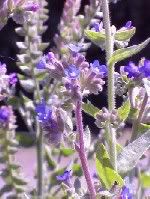

Alkanet (Alkanna tinctoria; Anchusa spp, A officinalis)
Folk Names: A. officinalis - Alhinna (Arabic - Henna), Alkanna, Bugloss, Common Alkanet; A tinctoria – Anchusa, Dyer’s Bugloss, Spanish Bugloss, Orchanet
Anchusa officinalis is a member of Borage family. It is a perennial or biennial, depending upon the region in which it is grown. It will grow in most waste places and along roadsides, though it does like a little fertilizer. This European native has naturalized to Maine, south to New Jersey and west to Ohio and Michigan. Its stem and foliage is coarse and usually hairy. The stem may be from one to five feet. The lower leaves stalked and up to 8 in long. The upper leaves are narrow, oblong to lanceolate, and up to six inches long and one inch wide without stalks, Alkanet has masses of small, tubular flowers 1/4 inch across and usually violet-blue. These appear from May to October, producing tiny nut-like fruits.
Alkanna tinctoria has basically the same description as A. officinalis. The flowers of some species are yellow or whitish. The root is very large in proportion to the plant, and the rind yields a red dye similar to henna.
Effects: gentle
Planet:
Element: Water
Associated Deities: Venus (according to Culpepper)
Traditions:
Magic:
Alkanet has been used mostly as an incense to dispel negativity or to attract prosperity. Considering its similarity in use as a dye to henna, it could be put to good use as a temporary tattoo for these purposes as well.
Dioscorides recommended the use of alkanet internally for snakebite. As an astringent, it might be better used as a poultice to draw the poison out. He also said that you could spit into the mouth of serpent after eating it, and it would instantly die, but this seems to be just asking to be bitten.
Known Combinations:
none noted
Medical Indications: Parts Used : (some indications that prolonged internal use may cause cancer)
Alkanet is an old folk medicine for depression. It was used as an expectorant to ease cough and promoted sweating to break fever. It is said to soften and sooth skin. Alkanet acts as a diuretic and blood purifier. As an astringent, it has been recommend for bruises and small scrapes since ancient times. They went so far as to recommend it not only for pox and measles, but also for leprosy.
Nutrition:
none noted
Mercantile Uses:
Though the plant is sometimes cultivated in Britain, the largest exporter is France. The name Anchusa comes from the Greek anchousa meaning paint. A red dye used like henna may be derived from the roots of both plants. The dye is readily extracted by the use of oils or alcohol. In addition to a use as a henna substitute, the dye has been made into a stain for imitation rosewood or mahogany, and is used in pharmacies to give salves a red color. Wax tinged with alkanet is applied to the surface of warm marble, staining it a flesh color which sinks deep into the stone. In Victorian times, it is said to have been used as a temporary rouge.
Alkanet attracts bees and may be used in the garden for this purpose.